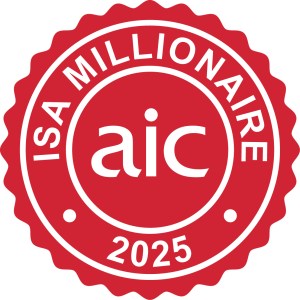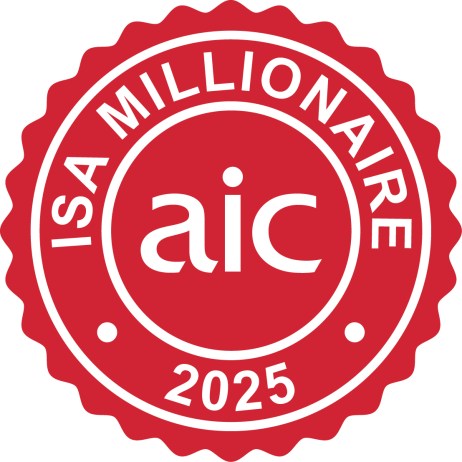By their nature, investment trusts are designed for long-term investing. This is a message that has been reinforced in the findings of recent research from the Association of Investment Companies (AIC).
The AIC has found that 50 investment trusts would have made investors ISA millionaires if they had invested their full ISA allowance in them each year between 1999 and 2024. To read more about the research and its full methodology, please click here.
Among the trusts managed by Janus Henderson Investors, three were named as part of the list. Per the research, from an initial investment of £326,560 invested over the period:
- The European Smaller Companies Trust (formerly TR European Growth) would have left investors with £1,295,133.
- Henderson European Trust (formerly Henderson European Focus Trust) would have left investors with £1,146,372.
- Bankers Investment Trust, which invests in global stocks, would have left investors with £1,103,182.
Investment trusts have several features that aid long-term investing. Most notably, a permanent capital structure means that investment trusts are never forced sellers of the underlying assets they invest in, regardless of market turmoil or investment fads. This is particularly beneficial when investing in something with less liquidity, like smaller companies.
They are also able to use facilities like gearing – borrowing money – to enhance returns when borrowing is cheap and they see opportunity in the market (although it must be stressed that gearing can also exacerbate losses).
To find out more about our range of trusts, please click here.
Find out more about the AIC’s ISA millionaires here.

Gearing
Gearing is a measure of a company’s debt relative to its equity, showing how far its operations are funded by lenders versus shareholders. Investment trusts: The effect of borrowing money for investment purposes (financial gearing). The amount a company can “gear” is the amount it can borrow in order to invest.
Liquidity/Liquid assets
Liquidity is a measure of how easily an asset can be bought or sold in the market. Assets that can be easily traded in the market in high volumes (without causing a major price move) are referred to as ‘liquid’.
Disclaimer
Use of third party names, marks or logos is purely for illustrative purposes and does not imply any association between any third party and Janus Henderson Investors, nor any endorsement or recommendation by or of any third party. Unless stated otherwise, trademarks are the exclusive property of their respective owners
Not for onward distribution. Before investing in an investment trust referred to in this document, you should satisfy yourself as to its suitability and the risks involved, you may wish to consult a financial adviser. This is a marketing communication. Please refer to the AIFMD Disclosure document and Annual Report of the AIF before making any final investment decisions. Past performance does not predict future returns. The value of an investment and the income from it can fall as well as rise and you may not get back the amount originally invested. Tax assumptions and reliefs depend upon an investor’s particular circumstances and may change if those circumstances or the law change. Nothing in this document is intended to or should be construed as advice. This document is not a recommendation to sell or purchase any investment. It does not form part of any contract for the sale or purchase of any investment. We may record telephone calls for our mutual protection, to improve customer service and for regulatory record keeping purposes.
Issued in the UK by Janus Henderson Investors. Janus Henderson Investors is the name under which investment products and services are provided by Janus Henderson Investors International Limited (reg no. 3594615), Janus Henderson Investors UK Limited (reg. no. 906355), Janus Henderson Fund Management UK Limited (reg. no. 2678531), (each registered in England and Wales at 201 Bishopsgate, London EC2M 3AE and regulated by the Financial Conduct Authority), Tabula Investment Management Limited (reg. no. 11286661 at 10 Norwich Street, London, United Kingdom, EC4A 1BD and regulated by the Financial Conduct Authority) and Janus Henderson Investors Europe S.A. (reg no. B22848 at 78, Avenue de la Liberté, L-1930 Luxembourg, Luxembourg and regulated by the Commission de Surveillance du Secteur Financier).
Janus Henderson is a trademark of Janus Henderson Group plc or one of its subsidiaries. © Janus Henderson Group plc
Important information
Please read the following important information regarding funds related to this article.
- The Company has significant exposure to Emerging Markets, which tend to be less stable than more established markets. These markets can be affected by local political and economic conditions as well as variances in the reliability of trading systems, buying and selling practices, and financial reporting standards.
- If a Company's portfolio is concentrated towards a particular country or geographical region, the investment carries greater risk than a portfolio that is diversified across more countries.
- The portfolio allows the manager to use options for efficient portfolio management. Options can be volatile and may result in a capital loss.
- Where the Company invests in assets that are denominated in currencies other than the base currency, the currency exchange rate movements may cause the value of investments to fall as well as rise.
- This Company is suitable to be used as one component of several within a diversified investment portfolio. Investors should consider carefully the proportion of their portfolio invested in this Company.
- Active management techniques that have worked well in normal market conditions could prove ineffective or negative for performance at other times.
- The Company could lose money if a counterparty with which it trades becomes unwilling or unable to meet its obligations to the Company.
- Shares can lose value rapidly, and typically involve higher risks than bonds or money market instruments. The value of your investment may fall as a result.
- The return on your investment is directly related to the prevailing market price of the Company's shares, which will trade at a varying discount (or premium) relative to the value of the underlying assets of the Company. As a result, losses (or gains) may be higher or lower than those of the Company's assets.
- The Company may use gearing (borrowing to invest) as part of its investment strategy. If the Company utilises its ability to gear, the profits and losses incurred by the Company can be greater than those of a Company that does not use gearing.
- All or part of the Company's management fee is taken from its capital. While this allows more income to be paid, it may also restrict capital growth or even result in capital erosion over time.
